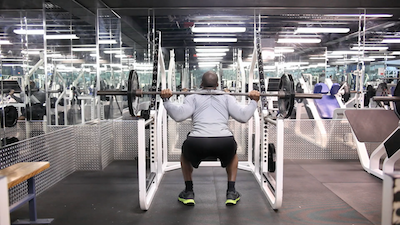Watch Squat
For over 50 pre-designed workouts you can bring straight to the gym, view EMG’s Workout Routines.
Description:
Step 1. Before you begin, set the safety guards at the side just below the lowest point of your motion in the event you have to drop the weight.
Step 2. With your feet shoulder-width apart, position yourself underneath the bar. The center of the bar should be positioned in the center of the back. The bar should rest on the upper back and shoulders not the neck.
Step 3. When standing beneath the bar your knees should be slightly bent. Push up, straightening your legs and removing the bar from the rack.
Step 4. Take a step back so there is space between the rack and your body.
Step 5. Bend at the knees and lower the weight. Keep you back straight and bend at the waist as you lower. Keep you toes straight forward and make sure that your knees do not go inward as you lower the weight. All you weight should be on your heels.
Step 6. When your thighs are parallel to the ground, press back up and straighten your legs. As you push with your legs, push forward with your pelvis to help drive the weight up.
Step 7. Once you have finished your repetitions, walk forward until the bar touches the rack and then lower it.
Notes:
The squat is the primary exercise for building size and strength in the legs. With a proper and full range of motion, it works the quads, hamstrings, and glutes. Users must be very careful when performing this exercise, as it is very easy to be injured when performing the it. A key aspect to pay attention to is to not round the back at any point in the exercise. A good technique for assuring this is to keep your head back and look toward where the ceiling meets the wall throughout the motion. Another key aspect is keeping balance through this exercise. To help with this, the user should keep his weight on his heels. To test this, the user should be able to wiggle his toes easily at any time during the exercise. The typical stance for a squat is slightly wider than shoulder-width. The user may angle their toes outward and use a wider stance if working the inner part of the leg is desired.
Updated: March 30th, 2015






